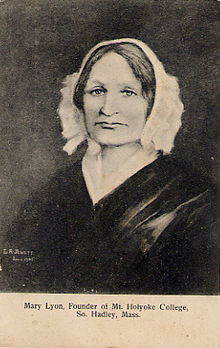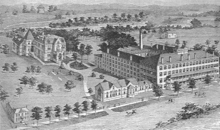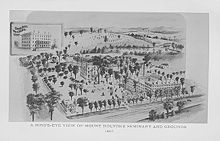| Mount Holyoke College | |
|---|---|
 Seal of Mount Holyoke College | |
| Motto | That our daughters may be as corner stones, polished after the similitude of a palace — Psalms 144:12 |
| Established | Seminary, 1837 (Seminary charter, 1836) Seminary and College, (Collegiate charter) 1888 College, 1893 |
| Type | liberal arts women's college |
| Endowment | $582.6 million (2012)[1] |
| President | Lynn Pasquerella |
| Academic staff | 200[2] |
| Students | 2,300[3] |
| Location | South Hadley, MA, USA |
| Campus | 2,000 acres (8.1 km²), academic campus: 1,000 acres (4.0 km2) |
| Colors | Light blue and white |
| Nickname | MoHo, Holyoke, or MHC |
| Mascot | Lyon |
| Website | mtholyoke.edu |
Mount Holyoke College is a selective liberal arts college for women in South Hadley, Massachusetts, United States. It was the first member of the Seven Sisters colleges, and served as a model for some of the others. Mount Holyoke is part of the Pioneer Valley's Five College Consortium, along with Amherst College, Smith College, Hampshire College, and the University of Massachusetts Amherst.
The school was originally founded in 1837 by Mary Lyon as Mount Holyoke Female Seminary. It received its collegiate charter in 1888 as Mount Holyoke Seminary and College and became Mount Holyoke College in 1893. Mount Holyoke's chapter of Phi Beta Kappa was established in 1905.
Mount Holyoke's buildings were designed between 1896 and 1960. It has a Donald Ross-designed 18-hole golf course, The Orchards, which served as host to the U.S. Women's Open in 2004.[4] U.S. News & World Report lists Mount Holyoke as the 29th best liberal arts college in the United States in its 2011 rankings.[5] Mount Holyoke was also ranked #1 in the nation for Best Classroom Experience in the Princeton Review 2010–2011 rankings.[6] In 2011–2012, Mount Holyoke is one of the nation's top producers of Fulbright Scholars, ranking fourth among bachelor's institutions according to the Chronicle of Higher Education.[7]
History
Mount Holyoke's founder, Mary Lyon, is considered by many scholars to be an innovator in the area of women's education.[8] Her establishment of Mount Holyoke Female Seminary was part of a larger movement to create institutions of higher education for young women during the early half of the 19th century. Lyon's contemporaries include Sarah Pierce (Litchfield Female Academy, 1792); Catharine Beecher (Hartford Female Seminary, 1823); Zilpah P. Grant Banister (Ipswich Female Seminary, 1828); George Washington Doane (St. Mary's Hall, 1837 now called Doane Academy). Prior to founding Mount Holyoke, Lyon contributed to the development of both Hartford Female Seminary and Ipswich Female Seminary. She was also involved in the creation of Wheaton Female Seminary (now Wheaton College, Massachusetts) in 1834.[8] Mount Holyoke Female Seminary was originally chartered as a teaching seminary in 1836[9] and opened its doors to students on 8 November 1837. Both Vassar College and Wellesley College were patterned after Mount Holyoke.[10] Mount Holyoke College now stands as the sister school to Ivy League Dartmouth College in NH.
From its founding in 1837, Mount Holyoke Female Seminary "had no religious affiliation". However, "students were required to attend church services, chapel talks, prayer meetings, and Bible study groups. Twice a day teachers and students spent time in private devotions. Every dorm room had two large lighted closets to give roommates privacy during their devotions".[11] Mount Holyoke Female Seminary was the sister school to Andover Seminary. Some Andover graduates looked to marry students from the Mount Holyoke Female Seminary before becoming missionaries because the American Board of Commissioners for Foreign Missions (ABCFM) required its missionaries to be married before starting their missions. By 1859 there were more than 60 missionary alumnae; by 1887 the school's alumnae comprised one-fifth of all female American missionaries for the ABCFM; and by the end of the century, 248 of its alumnae had entered the mission field.[12]
Mount Holyoke Female Seminary received its collegiate charter in 1888, becoming Mount Holyoke Seminary and College. In 1893 it became Mount Holyoke College. Mount Holyoke's chapter of Phi Beta Kappa was established in 1905. It has been a sister school to Women's Christian College in Chennai, Tamil Nadu, India since 1920. In the early 1970s Mount Holyoke had a long debate under the presidency of David Truman over the issue of coeducation. On 6 November 1971 the board of trustees voted to remain a women's college.[13]
On February 28, 1987, the United States Postal Service's Great Americans Series issued a postage stamp featuring Mary Lyon, in honor of Mount Holyoke's Sesquicentennial (Mount Holyoke's 150th anniversary).[14][15]
Academics
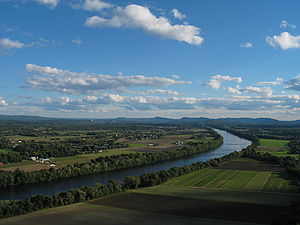
Majors, minors, and degrees
Mount Holyoke offers 50 departmental and interdepartmental majors, including the option to design a special major. The primary degree conferred is the Bachelor of Arts (BA) degree, for which students complete 128 semester credits (one standard course equals 4 credits). At least 68 credits must be earned from course work outside the major department, across the three curricular divisions: humanities, science and mathematics, and social sciences. Study of a foreign language and completion of a multicultural perspectives course are also required.[16]
In addition to the BA, Mount Holyoke offers three master’s degrees: a coed master of arts in teaching,[17] a master of arts in mathematics teaching,[18] and a master's in psychology.[19] Other programs include dual-degree programs in engineering with the California Institute of Technology, the Thayer School of Engineering at Dartmouth College, and the University of Massachusetts Amherst;[20] the Frances Perkins Program,[21] for women over the age of 24 who wish to complete the requirements for a bachelor of arts degree; and the Postbaccalaureate Studies Program,[22] for students who have already earned an undergraduate degree and wish to complete additional course work in preparation for graduate work in medicine, nursing, veterinary medicine, dentistry, or physical therapy science.
Mount Holyoke’s membership in the Five College Consortium allows students to enroll in courses at Amherst College, Smith College, Hampshire College, and the University of Massachusetts Amherst. They may also complete one of 12 Five College Certificates—among them African studies, Buddhist studies, coastal and marine sciences, cognitive neuroscience, international relations, and Middle Eastern studies—in lieu of a minor.[23]
Academic centers
Four academic centers—the Weissman Center for Leadership,[24] the McCulloch Center for Global Initiatives,[25] the Miller Worley Center for the Environment,[26] and the Science Center[27]—support the academic program through public lectures by visiting scholars, conferences on issues of pressing concern, mentoring and internship opportunities, and hands-on learning experiences. The Weissman Center’s Speaking, Arguing, and Writing Program[28] provides opportunities for developing leadership and communication skills, including the ability to effectively frame, articulate, and advocate positions. The Community-Based Learning Program[29] links students with community-based organizations in courses that combine analysis and action.
Study abroad
Mount Holyoke has study abroad programs and exchanges for full-year or semester study in France, Senegal, Costa Rica, Chile, Hong Kong, Japan, Korea, Germany, Spain, and the UK, as well as a summer program in China and January Term programs in the Republic of Georgia and South Africa. Each year more than 200 Mount Holyoke students, representing approximately 40 percent of the junior class, study for a semester or academic year at universities and programs abroad.[30]
Library
Mount Holyoke’s library includes more than 740,000 print volumes, 1,600 periodicals, and more than 140,000 electronic resources. Through the Five College Consortium, students have access to more than 8 million volumes.[31] Computer support is provided.[32] The MEWS (Mediated Educational Work Space) supports collaborative multimedia learning with group project rooms, wall-mounted plasma displays, a digitization center, and a faculty development area.[33]
Faculty
A number of faculty are nationally and internationally recognized for their research and writing achievements, including Christopher Benfey (literary scholar), Joseph Ellis (historian), Susan Barry (neurobiologist), Mark McMenamin (geologist and paleontologist) and Becky Wai-Ling Packard (psychologist). Student research projects, undertaken in collaboration with faculty, have made significant contributions to the sciences and other fields of study.
Campus
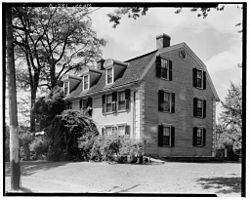
The 800-acre (3.2 km2) campus was designed and landscaped between 1896 and 1922 by the landscape architecture firm of Olmsted and Sons. The campus includes a botanic garden, two lakes, several waterfalls, tennis courts, stables and woodland riding trails. it is also home to the Mount Holyoke College Art Museum which is part of the Five College Museums/Historic Deerfield and the Museums10. An independent bookstore, The Odyssey Bookshop, is located directly across from the campus in the college-owned Village Commons.[34] Mount Holyoke has instituted “The Big Turn Off” energy conservation campaign.[35] It also focuses on "green" building with five LEED certified buildings on campus.[36] It has reduced its environmental impact by recycling 40% of waste and composting as well as using produce grown in the student-run organic garden in dining halls.[37]
The home of Benjamin Ruggles Woodbridge, known as "The Sycamores", served as a dormitory for the college from 1915–1970.[38][39] The mansion, built in 1788 by Colonel Woodbridge, is on the National Register of Historic Places.
Mount Holyoke is also close to the cities of Amherst and Northampton as well as to two malls: Hampshire Mall and Holyoke Mall. The Mount Holyoke Range State Park is also close to the campus. The college is named after the westernmost mountain of the range Mount Holyoke which was named by colonial surveyors in the 1600s.
Organization
Mount Holyoke is a member of the Pioneer Valley's Five College Consortium, the Consortium of Liberal Arts Colleges, the Annapolis Group, and the Oberlin Group. It was a part of The New College Plan. It is currently a part of The Consortium on Financing Higher Education and The Knowledge Corridor.
WMHC (91.5 FM) is a radio station licensed to serve South Hadley, Massachusetts. The station is owned by Mount Holyoke College and licensed to the Trustees of Mount Holyoke.
Students
Mount Holyoke has a student population of 2,300. Students come from "48 states and nearly 70 countries. Two-thirds of the student body are Caucasian American; one-third is an international student or African American, Asian American, Latina, Native American, or multiracial. Thirty-six percent of incoming first-year students were in the top five percent of their high school classes".[40] Mount Holyoke also attracts a large international population.[41] Male students may enroll in classes through the Five College Consortium.
Student groups
Mount Holyoke offers a number of student groups and organizations. Themes include Art, Academics, Club Sports, Entertainment & the Performing Arts, Politics & Activism, Governing Organizations and Religious organizations.[42]
Traditions
The Kathryn Irene Glascock Awards, grants The Glascock Prize to the winner of this annual event (which has been held at Mount Holyoke since 1924).[43]
The Faculty Show takes place once every four years, around 1 April faculty members create a show which parodies themselves and their students.[44]
The Junior Show (also known as J-Show) refers to a show created by Juniors (and a few professors) who parody life at Mount Holyoke. A common feature is a sketch mocking the president and dean of the college, along with well-known professors.[45]
Mountain Day begins with the sound of ringing bells from Abbey Chapel on a beautiful autumn morning secretly chosen by the President of the College and all classes are canceled for the day and many students hike to the summit of nearby Mount Holyoke.[46]
M&C's, originally called Milk & Crackers, is now referred to as Milk & Cookies.[47] M&Cs are a nightly snack provided by dormitory dining halls, but also refer to a student a cappella group, M&Cs (Milk and Cookies)[48]
Big/Little Sister is a reference to the pairing of juniors and firsties (or first-years) who are paired up to take part in organized events together. Coordinated by the Junior Class board.
Elfing is a tradition shared between sophomores and first years. Secret sophomore "elves" leave presents and treats for their first years throughout the weeklong event. On the final day, the first years get to meet their elves in person at a special M&C's.
Founder's Day is held on the Sunday closest to 8 November (the date of the opening of Mount Holyoke in 1837). It was begun by Elizabeth Storrs Mead in 1891. The current version of the tradition includes ice cream being served early in the morning near Mary Lyon's grave. The current President of the College and select faculty are invited to scoop ice cream for the Senior Class who dons their gowns.[49]
Convocation marks the beginning of the academic year. All students attend wearing their class colors, and seniors wear their graduation gowns to celebrate the start of their final year.
Canoe Sing is an event which takes place prior to commencement in which canoes are decorated with lanterns and paddled by seniors singing Mount Holyoke songs. They are joined by fellow graduating seniors on shore.
Baccalaureate is held in Abbey Chapel; the medieval German ode to Academe, "Gaudeamus Igitur" is sung by berobed Seniors and Faculty during the procession. Following convocation, Faculty line the path to Mary Lyon's grave. Seniors walk through this throng, to the grave (to place a wreath).
The Laurel Parade takes place the day before commencement. Graduating seniors wear white and carry laurel garlands, in a parade to Mary Lyon's grave. They are escorted by approximately 3,000 alumnae, also in white, who thereby welcome them into the Alumnae Association. Once at Mary Lyon's grave, the garland is wound around the cast-iron fence, and the Mimi Farina song "Bread and Roses" is sung by all in attendance. White is a tribute to those who fought for women's suffrage.[50] In 1970 students voted to replace the laurel with signs protesting the Vietnam War.[51]
Athletics
Mount Holyoke offers 14 varsity sports programs and seven competitive club sports teams. The College is a member of the National Collegiate Athletic Association (NCAA) Division III and the New England Women's and Men's Athletic Conference (NEWMAC) as well as the NERC (the New England Rowing Conference).[52] Facilities include a lighted synthetic multipurpose turf field surrounded by an eight-lane track with a nine-lane straightaway; Kendall Sports and Dance Complex housing a swimming pool and separate diving well; gymnasium with basketball, volleyball, and badminton courts; weight room; cardiovascular area; 1-acre (4,000 m2) field house with indoor track and tennis courts; squash courts; racquetball courts; and three studios for dance, aerobics, yoga, and other activities; The Orchards, an 18-hole golf course designed by Donald Ross (home to the 2004 U.S. Women's Open); and a 60-stall Equestrian Center with two indoor arenas (100' x 256' and 70' x 130'), an outdoor show ring, permanent fibar dressage arena, outdoor cross-country courses, and a boathouse finished for Spring 2010.[53]
Noted people
The main article provides a list of individuals associated with Mount Holyoke through attending as a student, or serving as a member of the faculty or staff.
In art and media
Mount Holyoke is referenced in works of theater, film, and popular culture. Wendy Wasserstein's 1977 play, Uncommon Women and Others, is based upon Wasserstein's experiences at Mount Holyoke of the early 1970s. The play explores the lives of the fictional characters Carter, Holly, Kate, Leilah, Rita, Muffet, Samantha, and Susie. Two feature films reference Mount Holyoke of the 1960s. The first is the 1987 film Dirty Dancing which is set at a summer resort in the Catskills in the summer of 1963. The protagonist Frances "Baby" Houseman (named after Mount Holyoke graduate Frances Perkins) plans to attend Mount Holyoke in the fall to study economics of underdeveloped countries and then to later enter the Peace Corps. The second is the 1978 film National Lampoon's Animal House which is set in 1962. It satirizes a common practice up until the mid-1970s, when women attending Seven Sister colleges were connected with or to students at Ivy League schools. In the film, fraternity brothers from Delta house of the fictional Faber College (based on Dartmouth College[54]) take a road trip to the fictional Emily Dickinson College (Mount Holyoke College)--in real life, Mount Holyoke and Dartmouth are unofficial brother-sister schools.
Notes
- ^ As of June 30, 2012. "U.S. and Canadian Institutions Listed by Fiscal Year 2012 Endowment Market Value and Percentage Change in Endowment Market Value from FY 2011 to FY 2012" (PDF). 2012 NACUBO-Commonfund Study of Endowments. National Association of College and University Business Officers.
- ^ "Faculty | Mount Holyoke College". Mtholyoke.edu. Retrieved 2012-07-14.
- ^ "Fast Facts | Mount Holyoke College". Mtholyoke.edu. Retrieved 2012-07-14.
- ^ Shefter, David. "Location Ideal For 2004 Women’s Open: Championship Course Was Built For A Woman, Owned By All-Female College". uswomensopen.com. Retrieved 2006-09-01.
- ^ "Best Colleges: Liberal Arts Rankings". p. 2.
- ^ "College Rankings". princetonreview.com.
- ^ "Top Producers of U.S. Fulbright Students by Type of Institution, 2011–12". Chronicle of Higher Education.
- ^ a b Alma Mater: Design and Experience in the Women's Colleges from Their ... – Helen Lefkowitz Horowitz – Google Boeken. Books.google.com. Retrieved 2012-07-14.
- ^ First Charter of Mount Holyoke. Books.google.com. 2007-01-05. Retrieved 2011-02-20.
- ^ Jennifer L. Crispen. "Seven Sisters and a Country Cousin". sbc.edu.
- ^ "Daily Life at Mount Holyoke". mtholyoke.edu. Retrieved 2006-09-01.
- ^ "Did You Know?". Christian History & Biography 90: 3–4. Spring 2006.
- ^ "Mount Holyoke:A Detailed History". mtholyoke.edu.
- ^ AP (1986-12-21). "Stamp for Holyoke Founder". New York Times. Retrieved 2011-02-20.
- ^ "The Mary Lyon Stamp". mtholyoke.edu. Retrieved 2006-09-01.
- ^ "Degrees and Requirements | Mount Holyoke College". Mtholyoke.edu. Retrieved 2012-07-14.
- ^ [1]
- ^ [2]
- ^ [3]
- ^ "Dual-Degree Engineering Options". Mount Holyoke College. Retrieved 2012-07-14.
- ^ "Frances Perkins Program". Mount Holyoke College. Retrieved 2012-07-14.
- ^ "Postbaccalaureate Pre-Medical Program". Mount Holyoke College. Retrieved 2012-07-14.
- ^ "www.fivecolleges.edu". www.fivecolleges.edu. 2012-06-22. Retrieved 2012-07-14.
- ^ [4]
- ^ "McCulloch Center for Global Initiatives | Mount Holyoke College". Mtholyoke.edu. Retrieved 2012-07-14.
- ^ [5]
- ^ "Science Center | Mount Holyoke College". Mtholyoke.edu. Retrieved 2012-07-14.
- ^ [6]
- ^ [7]
- ^ [8]
- ^ "Library | Mount Holyoke College". Mtholyoke.edu. Retrieved 2012-07-14.
- ^ "Computers and Technology | Mount Holyoke College". Mtholyoke.edu. Retrieved 2012-07-14.
- ^ [9]
- ^ "In the Valley of the Literate". Nytimes.com. 2007-11-16. Retrieved 2011-02-20.
- ^ "Mount Holyoke College :: News :: MHC's New Energy Conservation Campaign". Mtholyoke.edu. 2006-11-13. Retrieved 2011-02-20.
- ^ "Env Responsible Building :: Environmental Stewardship :: Mount Holyoke College". Mtholyoke.edu. Retrieved 2011-02-20.
- ^ "Amherst College – Green Report Card 2009". Greenreportcard.org. 2007-06-30. Retrieved 2011-02-20.
- ^ "Historic House to be Moved October 19". Mtholyoke.edu. 2004-10-15. Retrieved 2011-02-20.
- ^ "Mount Holyoke College Archives and Special Collections". Mtholyoke.edu. Retrieved 2011-02-20.
- ^ "Facts". mtholyoke.edu. Retrieved 2006-09-01.
- ^ ‘Sisters’ Colleges See a Bounty in the Middle East
- ^ Mount Holyoke College. "Org Directory :: Student Programs :: Mount Holyoke College". Mtholyoke.edu. Retrieved 2011-02-20.
- ^ "Kudos:Recognition for Dartmouth faculty, staff, and students". dartmouth.edu. Retrieved 2006-12-10.
- ^ "Photo Gallery | Mount Holyoke College". Mtholyoke.edu. Retrieved 2012-07-14.
- ^ "Photo Gallery | Mount Holyoke College". Mtholyoke.edu. Retrieved 2012-07-14.
- ^ "Heading for the Hills on Mountain Day: It's Been a Mount Holyoke Tradition Since 1838". mtholyoke.edu. Retrieved 2006-09-01.
- ^ "Traditions: M & Cs (milk and crackers)". mtholyoke.edu. Retrieved 2006-09-16.
- ^ "About the M&Cs". Mtholyoke.edu. Retrieved 2012-07-14.
- ^ "Traditions: Founder's Day". Mtholyoke.edu. Retrieved 2011-02-20.
- ^ "100 Years of Laurel and Other Commencement Customs". mtholyoke.edu. Retrieved 2006-09-01.
- ^ "100 Years of Laurel and Other Commencement Customs". mtholyoke.edu. Retrieved 2012-05-10
- ^ [10] Athletics
- ^ "Mount Holyoke Athletics : Mount Holyoke Athletics Facilities". Mtholyoke.edu. Retrieved 2012-07-14.
- ^ Landis, John (2003-08-29). Interview with Soledad O'Brien. Live from the Headlines. CNN. .
Further reading
- Harwarth, Irene B. "A Closer Look at Women's Colleges." National Institute on Postsecondary Education, Libraries, and Lifelong Learning, Office of Educational Research and Improvement, U.S. Department of Education, 1999.
- Harwarth, Irene B., Mindi Maline and Elizabeth DeBra. "Women's Colleges in the United States: History, Issues, and Challenges: Executive Summary." U.S. Department of Education National Institute on Postsecondary Education, Libraries, and Lifelong Learning.
- Horowitz, Helen Lefkowitz. Alma Mater: Design and Experience in the Women's Colleges from Their Nineteenth-Century Beginnings to the 1930s, Amherst: University of Massachusetts Press, 1993 (2nd edition).
- Turpin, Andrea L. "The Ideological Origins of the Women’s College: Religion, Class, and Curriculum in the Educational Visions of Catharine Beecher and Mary Lyon," History of Education Quarterly, 50 (May 2010), 133–58.
External links
| |||||||||||||||||||||||
| |||||
| |||||
| |||||
| ||||||||||||||||||||
| |||||
| |||||
